OK, here we go! This is the first of our comparative software tests on time-stretching and pitch-shifting. The competitors: 26 Mac and PC programs, from big sequencers to small applications, plug-ins to audio editors
OK, here we go! This is the first of our comparative software tests on time-stretching and pitch-shifting. The competitors: 26 Mac and PC programs, from big sequencers to small applications, plug-ins to audio editors
Digital audio has brought about many changes to the audio world when compared to analog. Is this good or bad? Everyone has their own opinion; but certain features have been improved, some totally new ones have emerged, while others are less effective or successful (knowing that many opinions are primarily subjective).
But the goal here is not to make (empty) comparisons between the two worlds. We’ll be dealing with two important features that have more or less created a revolution in music since their arrival with the earliest samplers: time-stretching and pitch-shifting. The first can speed up or slow down an audio file without changing its pitch, the second change its pitch without changing its tempo (otherwise, it’s back to tapes and vari-speed …).
Surprising Technologies
We sometimes get so used to the changes and/or new features offered by digital audio that we tend to become jaded and don’t realize the incredible possibilities that digital audio offers. Time stretch and pitch-shift are two good examples: how is it possible to change pitch to such an extant without getting a horrible sound? Whatever technology is used, it often consists of just filling in holes and spaces, which requires extremely precise interpolation calculation, in the case of Time stretch, and harmonic and formant alteration in the case of pitch-shift. On top of that, it must preserve phase, transients, placement, stereo, etc..
Some technologies include: phase vocoder, time domain harmonic scaling, sinusoidal/spectral modeling, granular re-synthesis, additive re-synthesis, neural networks, the wavelet transform, and so on. As for pitch shift, it has to, of course, maintain the same tempo (sometimes also referred to as Frequency Shift), while avoiding audio artifacts, and the chipmunk effect or the “voice from beyond the grave”. Certain programs allow you to work on formants separately via independent or automatic adjustments. But maybe it would be better to take a look at this Wikipedia article to learn some of the basics, and it also has some very well-chosen links that can give further information on both technologies.
The Contestants
So let’s take a look at the software that’ll be used for this comparison. It’s difficult to be truly exhaustive in such a test. And plus there has to be limits, or at least very simple “prerequisites”, so: the software, whether sequencer, virtual instrument or plug-in should have both time-stretch and pitch shift capabilities.
That therefore excludes Antares Auto-Tune, Intonator HS from TC-Helicon or Yamaha’s Pitch Fix, which only modify or correct pitch, and software like ReCycle! which uses the Rex format, or requiring special formats (such as Soundtrack Pro whose pitch functions are only available on Apple Loops), or various plug-ins included in sequencers. Two notable absentees that do however meet the two prerequisites are Audiosculpt and Speed by SoundToys.
Here’s the list of the software that was tested:
First batch, tested on Mac:
- Ableton Live 7.0.9
- Apple Logic Pro 8.0.2
- Bias Peak 6 XT
- Celemony Melodyne 3
- Digidesign Pro Tools LE 7.4
- i3 DSP Quattro
- IK Multimedia SampleTank2.5 XL
- Izotope Radius
- Native Instruments Kontakt 3
- Prosoniq TimeFactory 2.3
- Roni Music Amazing SlowDowner 3.2.3
- Serato Pitch’nTime Pro
- Serato Pitch’n Time LE
- USB UVIWorkstation
Second batch, that will be tested in part 2 on both Mac and PC.
-
Cakewalk Sonar 7 (MPEX3)
-
Mackie Tracktion 3 (élastique efficient V1.3)
-
Sonic Foundry SoundForge 9
-
Steinberg Cubase 4 (MPEX3)
-
Steinberg Wavelab 6 (DIRAC)
Whew! To test the capabilities of this bunch, six audio files will be used: a bass line, a drum loop with reverb (from Groovemasters Rhythm Essence), an acoustic guitar with reverb, strings, a vocal melody and a whole mix (a song from Peter Gabriel’s album So).
In short, it consists of simple and complex audio examples: the Gabriel mix, for example, has many elements that could potentially pose problems (the voice, sustained brass, the slightly open high hat, transients, different formants, etc..). Or the reverb and slides on the acoustic guitar sample. Or the “noises” in the bass sample …
Here are the values applied to the length of the original files for the time-stretch section: 75%, 90%, 110%, 133%, 200%, rounded up to the nearest decimal point. Note, that because almost every program has its own system (BPM, tempo percentage, length, frames, etc.), certain values will be slightly different.
From time to time, there’s an “extreme” setting like 400%, which will show the capabilities of these apps to produce useful results as tools(for transcribing a complex work for example), even if it won’t be used musically or in a mix. We won’t be taking into consideration time stretch applied in a “sound design” context, which is not the purpose of this comparison. One can of course get very interesting samples from files stretched to the extreme.
As for pitch-shifting, we’ll be transposing up and down a whole-step (2 half-steps), a fourth (5 half-steps), and an octave (12 half-steps). Let’s go…
Software Features: Part I
 |
We’ll briefly present the settings and features of each program, since they all work in different ways. The idea of comparison is to achieve the best possible result on the audio examples using all the features offered by each program. Since there are more than 1000 files for this first part, it’s not possible to discuss each result each time.
Live, Ableton’s famous tracker, made a big impression when it was first released. Used here in v.7.0.9, its Warp mode allows you to specify which types of files are to be addressed: Beats, Tones, Texture, Re-Pitch, and Complex. A Hi-Q mode, heavy on resources, but of better quality, is also available. It of course works in real time. We used the Complex method on most files, and Beats on the drum loop. Live uses the algorithm developed by z-plane, the elastic efficient v.1.3.
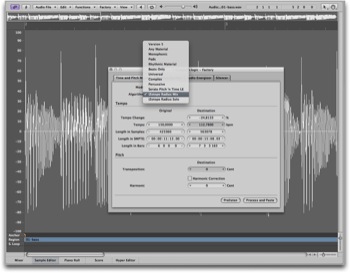 |
Apple Logic Pro, here in its latest version (8.0.2). Although it offers stretch from its Arrange window, it only works offline, because it takes the time to calculate transposition/compression/expansion. One can work in the Sample Editor window, thanks to Time and Pitch Machine. Several algorithms are available: Version 5, Any Material, Monophonic, Pads, Rhythmic Material, Beats Only, Complex, and Percussion. Note that you can install third-party software like Serato Pitch’nTime LE and iZotope Radius. The Pitch-shift has harmonic correction, which was used more or less depending on the examples. The algorithms that were used were Complex, Monophonic and Percussion. There aren’t any details about the technologies they use, but they’re all by Apple and Emagic.
 |
6 Peak XT (v.6.0.3) from BIAS, also uses the z-plane algorithm (elastic efficient v.1.3), but offline. The menu offers DSP windows dedicated to Pitch Shift and Time Stretch (Change Duration), with simple functions: three types of file management, Spoken Voice, Music and Music (percussion) and adjustments in half-steps and cents. A Phase Vocoder mode is available, which was one of the first Time stretching techniques. Note, Peak offers the possibility of variable change of time and pitch, by drawing curve percentages. The Music and Music (Percussion) algorithms were used.
 |
Melodyne Studio (v.3.2.2.2), by Celemony, has its own technology, based on neural networks. The file is first analyzed, in three modes: Melodic, Percussion and Polyphonic. Note that you can re-analyze the file by choosing one of the other modes. It then modifies pitch in real-time by moving the whole file, or note by note, along a scale of half-steps, with the mouse, the keyboard, via the menu or via Midi. For time stretch, you can activate the Autostretch in the transport bar or use the menu options, the software immediately lines everything up. Melodyne offers very sophisticated features for pitch variation correction, shape, volume, length of notes, legato from one to another and so on. None of these features, except sometimes a formant adjustment, have been used, this not being the purpose of this comparison.
.
Software Features: Part II
 |
Pro Tools LE, from Digidesign, integrates, since v.7.4, the Elastic Audio function (here in v.7.4.2). The former TCE is complemented with a brand new Time Shift, an optional X-form plug-in, using iZotope’s Radius. Just one option box, and any imported audio file will be ready to go. You can choose between five modes: Polyphonic, Rhythmic, Monophonic, Varispeed and X-Form (optional, and only offline). The Time Shift plug-in offers the first four, then the Range menu lets you specify the type of spectral content of a file (Low, Mid, High, Wide). In Mono mode, there’s a Formant section and in the other modes, a Transient section, which offers a setting for threshold detection as well as an analysis window (which is replaced by Decay Rate in Rhythmic mode). Last but not least, Pitch can transpose plus or minus two octaves. X-Form incorporates the same principle, with only three treatment types: Polyphonic, Monophonic and Poly Faster but with algorithms from iZotope’s Radius, and therefore better quality. For this test, the formant compensation will sometimes be activated, and sometimes not.
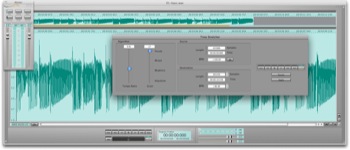 |
DSP-Quattro X (v.2.5.2), from i3 Software, can change pitch and length offline via two processing windows, Time Stretcher and Frequency Shifter. The first offers a Grain setting (Impulsive to Steady), Tempo Ratio, and a complete transport section for previewing. The second window includes the same transport functions and algorithms, plus an adjustable pitch in half-steps.
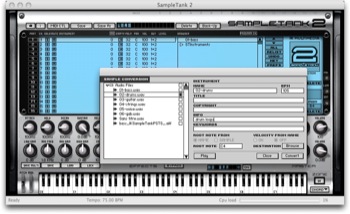 |
SampleTank 2.5 XL, from IK Multimedia, allows you to import samples, loops and other audio files. Three re-synthesis engines are available, two of which will be used for the test. PS/TS, for Pitch Shift/Time Stretch, to adjust length (10% to 1000%) and pitch (plus or minus three octaves), with a “grain” setting (there’s no precise information on what this setting is). Stretch takes the same settings and replaces Grain by Harm Pres (setting formant preservation) and Hrmncs (overall tone control for the re-synthesis samples).
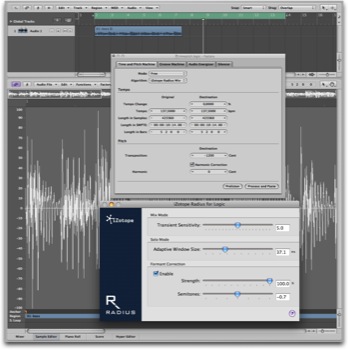 |
Radius, by iZotope, installs as a plug-in (it goes into the Components folder of Mac OS X) but is used in Logic’s Time Machine menu, therefore offline. It offers two modes: Mix and Solo. Some settings are accessible via an interface that’s executed from Applications, which sets transient detection, the size of the analysis window, and the correction rate (in half-steps) of formants; if this option is activated (don’t activate Logic’s at the same time). Radius offers the widest range of all the software in this test: time stretch between 12.5 and 800%, and transposition of plus or minus three octaves. Otherwise, the settings are the same as those available in Time Machine.
Software Features: Part III
 |
Kontakt 3, the sampler from Native Instruments, used z-plane’s elastic SOLOISTS algorithm (v.1.0) in versions 1 and 2 . No details on version 3 (3.0.2.004) tested here, but one would assume that the technology hasn’t changed. Four modes are available: Tone Machine (optimized for pitch-shifting), Time Machine (optimized for time-stretching in real time), Time Machine 2 (said to be better than Time Machine) and Beat Machine (for transient marked loops). The Sync/Slice tab can immediately synchronize a loop to a tempo by using either Time Machine 2 or Beat Machine. Some of the results are given here, in order, with and without the Transient Copy feature (a mode that keeps transients).
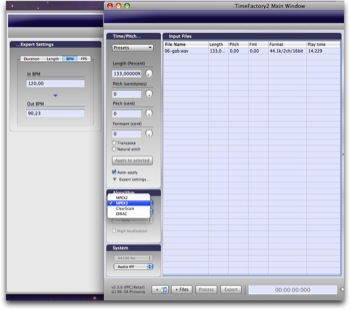 |
TimeFactory 2, by Prosoniq, offers four proprietary algorithms: MPEX2, MPEX3, Clear Scale, and DIRAC. We’ll be using only the last three for this test (MPEX3 is clearly better than MPEX2). It only works offline, sometimes with a long computing time. Each algorithm offers multiple levels of quality and/or patterns dedicated to a type of instrument or voice. You can change pitch and formants independently, and a Natural Pitch option lets you compensate the transposition of a file by automatically modifying formants.
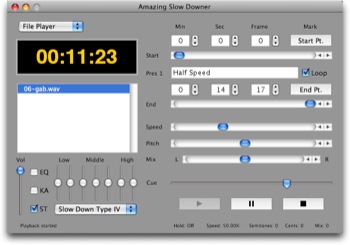 |
Amazing X or Amazing Slow Downer by Roni Music, specify that some technologies used are based on IRCAM’s Audiosculpt. This software can handle files from hard disks or CDs, features five treatment modes (only Slow Down Type IV was used). It also has an EQ to boost or cut certain frequencies (useful for transcribing), and recognizes many file types. The variations range from 20% to 200% in speed, and more or less an octave. It’s all done in real time, with the possibility of looping a section. The app can be controlled via MIDI, which is always practical when dealing with a standalone.
 |
Pitch’n Time Pro, and the more affordable Pitch’n Time LE by Serato, are used as plug-ins or within Logic (LE only) and Pro Tools (both versions) in offline mode. The LE version only has a single generic algorithm, whereas the Pro version lets you choose between three, B for sounds with strong transients, C for voice, A for everything else. Pitch’n Time Pro also has more features for complex variations (you can edit graphically, handy!), with envelope curves and morphing options. Another valuable function: Capture, which automatically adjusts the files to the same length as one whose length has already been stored.
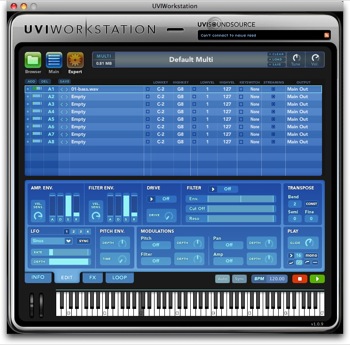 |
And to complete the software list of this first part, the UVIWorkstation by Univers Sons. This new declination of the UVIEngine offers time stretch and pitch shift, accessible via the Loop tab. It defines the basic tempo of the file (whether you know it or not). In the case of Tempo, Sync is placed on Tempo, and by changing the tempo in the overall BPM slot, the transformation takes place in real time. For pitch shift, just play them on the virtual keyboard.
Let’s listen now…
Bass: Time Stretch
|
Time Stretch Bass
|
75% |
90%
|
110%
|
133%
|
200%
|
400%
|
| Live |
---—
|
|||||
| Logic Pro |
---—
|
|||||
| Peak |
---—
|
|||||
| Melodyne | ||||||
| Pro Tools TS |
--—
|
|||||
| Pro Tools XForm |
--—
|
|||||
| DSP Quattro |
--—
|
|||||
| SampleTank TS |
--—
|
|||||
| SampleTank Stretch | ||||||
| Radius |
---—
|
|||||
| Kontakt |
--—
|
|||||
| TimeFactory II ClearScale |
--—
|
|||||
| TimeFactory II DIRAC |
--—
|
|||||
| TimeFactory II MPEX3 |
--—
|
|||||
| Amazing X | ||||||
| Pitcn ‘n Time LE |
--—
|
|||||
| Pitcn ‘n Time Pro |
---—
|
|||||
| UVIWorkstation |
--—
|
We begin with the maximum stretching chosen for this comparison, 75% of the original length, or one-third faster. There are some “quivering” artifacts here and there (SampleTank PS/TS, UVIWorkstation, Pro Tools TS, DSP Quattro), a loss of frequencies (Peak and Live, which seems logical since they use the same algorithm), a strange treatment of low notes (X-Form, Kontakt), a decrease in transients (Clear Scale, Time Pitch’n LE), and sometimes a combination of several defects … Note that Clear Scale produced a strange phenomenon on the waveform, that seems similar to, but not quite exactly, a reversal of phase; to be verified when testing stereo files.
At 90% of the original length (equivalent to going from 100 to 111.1 BPM) things are less blatant, but still present (even if slightly) with the same types of problems for each program.
Now we move on to slowing tempos down, 110% first, from 100 to 90.9 BPM. There are still differences (fortunately!), and the same type as before, which means that the same programs showed the same defects. Some clearly show that they couldn’t be used in a professional context on this file (DSP Quattro, UVI, Kontakt, Pro Tools TS, SampleTank PS/TS …).
At 133%, from 100 to 75.1 BPM, things get complicated. All those with artifacts are of course eliminated, and if we add to them all those who really leveled transients, the only ones to remain are Amazing X, Logic Monophonic, Melodyne, TimeFactory 2 DIRAC, and Radius.
The test at 200% doesn’t correspond to a “real” use in the audio world, outside a creative process. But again, we can see that some programs fared better than others, and if you are not too demanding, some parts could be used. Can you find which …
As for processed files at 400%, it’s once again purely for demonstrative purposes (but it may be useful for transcribing a Coltrane phrase at 210 or a heavy metal solo…). All the results are not listed, just what was audible …
Drums: Time Stretch
|
Time Stretch Drums
|
75% |
90%
|
110%
|
133%
|
200%
|
400%
|
| Live |
---—
|
|||||
| Logic Pro |
---—
|
|||||
| Peak |
---—
|
|||||
| Melodyne | ||||||
| Pro Tools TS |
--—
|
|||||
| Pro Tools XForm |
--—
|
|||||
| DSP Quattro |
--—
|
|||||
| SampleTank TS |
--—
|
|||||
| SampleTank Stretch |
--—
|
|||||
| Radius |
---—
|
|||||
| Kontakt |
--—
|
|||||
| TimeFactory II ClearScale |
--—
|
|||||
| TimeFactory II DIRAC |
--—
|
|||||
| TimeFactory II MPEX3 |
--—
|
|||||
| Amazing X | ||||||
| Pitcn ‘n Time LE |
--—
|
|||||
| Pitcn ‘n Time Pro |
---—
|
|||||
| UVIWorkstation |
--—
|
Most files have been treated with dedicated software algorithms whenever they exist. At 75%, Live, DSP Quattro, and SampleTank cut off transients, Peak weakens them, Kontakt gives a chopped up result, while those that respect transients give a weaker signal. We might wonder if there’s some kind of compensation used here: exaggeration of transients or lower level?
At 90%, Melodyne shows a slight envelope issue on the bass drum, as does Pitch’n Time Pro. Logic shows a loss above 16 kHz, SampleTank Stretch too, combined with shaved transients (PS/TS also). Kontakt always minces up the groove, some envelopes are shortened on UVI and transients diminished on Ableton, Peak, TimeFactory 2 MPEX3, and DSP Quattro.
Onto 110%: SampleTank PS/TS and Stretch, and Live slightly cut up the file and add transients. TimeFactory 2, MPEX3, Clear Scale, Pitch’n Time Pro and LE have a problem with the snare drum, with very quick filtering on its frequency, the famous phase problem, and consequently a transient decrease … Oddly enough Kontakt sounds better with Time Machine than Beat Machine (both versions are in the same file). TimeFactory 2 DIRAC adds some highs.
At 133%, the aforementioned problems are even worse, and Pro Tools TS gets added to the “those who chop” list … At 200%, everything goes bad, there’s even some Slapback, even if Melodyne or Amazing X are quite astonishing in terms of continuous audio. This is confirmed at 400%.
Gabriel: Time Stretch
|
Time Stretch Peter Gabriel
|
75% |
90%
|
110%
|
133%
|
200%
|
400%
|
| Live |
---—
|
|||||
| Logic Pro | ||||||
| Peak | ||||||
| Melodyne | ||||||
| Pro Tools TS |
--—
|
|||||
| Pro Tools XForm |
--—
|
|||||
| DSP Quattro |
--—
|
|||||
| SampleTank TS |
--—
|
|||||
| SampleTank Stretch |
--—
|
|||||
| Radius | ||||||
| Kontakt |
--—
|
|||||
| TimeFactory II ClearScale |
--—
|
|||||
| TimeFactory II DIRAC |
--—
|
|||||
| TimeFactory II MPEX3 |
--—
|
|||||
| Amazing X | ||||||
| Pitcn ‘n Time LE |
--—
|
|||||
| Pitcn ‘n Time Pro |
---—
|
|||||
| UVIWorkstation |
--—
|
Here comes a big mix: “Sledgehammer” by Peter Gabriel. Everything about this mix complicates the task of these programs. Thus, at 75%, SampleTank PS/TS, DSP Quattro, Peak, and Live show phase and transient issues, Pitch’n Time LE and Pro, TimeFactory MPEX3, show a decrease in transients, while Pro Tools TS and UVIWorkstation chop up the file. In Logic one can hear some serious effects of granulation in some lows. Kontakt’s results are completely messed up, the lows aren’t handled well at all, as well as SampleTank Stretch, which features a polytonal Pete Gabriel …
At 90%, the same defects, to which SampleTank PS/TS add a timing problem, while Logic, DSP Quattro, and UVIWorkstation join Kontakt in its failed lows management (in varying degrees). SampleTank Stretch is still churning out experimental music…
Slowing down, at 110%, most software fared relatively well, except SampleTank Stretch (true to its random bass lines) and Kontakt, SampleTank PS/TS, UVIWorkstation, DSP Quattro, Logic Complex, Pro Tools TS with whom we hear granulation in the lows, to a greater or lesser extent.
At 133%, few are really making the grade: damaged transients, phase problems, granulation in the lows, transient echoes, etc.. Still, some do get by … At 200%, only Radius and Amazing X leave the voice almost intact, the rest are suffering from this extreme change. At 400%, still just as an example, different principles, different algorithms, different results.
Guitar: Time Stretch
|
Time Stretch Guitar
|
75% |
90%
|
110%
|
133%
|
200%
|
400%
|
| Live |
---—
|
|||||
| Logic Pro |
---—
|
|||||
| Peak |
---—
|
|||||
| Melodyne |
---—
|
|||||
| Pro Tools TS |
--—
|
|||||
| Pro Tools XForm |
--—
|
|||||
| DSP Quattro |
--—
|
|||||
| SampleTank TS |
--—
|
|||||
| SampleTank Stretch |
--—
|
|||||
| Radius |
--—
|
|||||
| Kontakt |
--—
|
|||||
| TimeFactory II ClearScale |
--—
|
|||||
| TimeFactory II DIRAC |
--—
|
|||||
| TimeFactory II MPEX3 |
--—
|
|||||
| Amazing X |
--—
|
|||||
| Pitcn ‘n Time LE |
--—
|
|||||
| Pitcn ‘n Time Pro |
---—
|
|||||
| UVIWorkstation |
--—
|
With a lot of reverb, sustained chords, resonance, slides, transients, this file is not easy. And it already shows at 75%: Kontakt can’t do it at all, TimeFactory 2 Clear Scale and SampleTank Stretch have problems with lows, DSP Quattro gives us tremolo, while SampleTank PS/TS adds an expression pedal (no transients). Melodyne has a phase issue, same with Peak which decreases transients, which are also damaged in Pitch’n Time and Live. And as for their part, Logic, Pro Tools TS and X-Form, TimeFactory 2 MPEX3, and UVIWorkstation smear up the sound …
At 90%, it’s the same, except for Time Pitch’n which fared a little better with transients. At 110%, things change: Melodyne alters one or two attacks, Peak and Live still eat up a few transients, SampleTank Stretch, PS/TS and DSP Quattro “tremble”, Kontakt, Pro Tools TS and X-Form, TimeFactory 2 Clear Scale, and UVIWorkstation “wobble” more or less. When we slow down even more to 133%, there aren’t too many contenders left: Amazing X, Pitch’n Time Pro (with less transients just the same), TimeFactory 2 DIRAC, and Radius are at their limits …
At 200%, one can appreciate the efforts the programs make just to keep up continuous audio, but most of them take their toll on transients. The others just accentuate the defects they already had.
Strings: Time Stretch
|
Time Stretch |
75% |
90%
|
110%
|
133%
|
200%
|
400%
|
| Live |
---—
|
|||||
| Logic Pro |
---—
|
|||||
| Peak |
---—
|
|||||
| Melodyne |
---—
|
|||||
| Pro Tools TS |
--—
|
|||||
| Pro Tools XForm |
--—
|
|||||
| DSP Quattro |
--—
|
|||||
| SampleTank TS |
--—
|
|||||
| SampleTank Stretch |
--—
|
|||||
| Radius |
--—
|
|||||
| Kontakt |
--—
|
|||||
| TimeFactory II ClearScale |
--—
|
|||||
| TimeFactory II DIRAC |
--—
|
|||||
| TimeFactory II MPEX3 |
--—
|
|||||
| Amazing X |
--—
|
|||||
| Pitcn ‘n Time LE |
--—
|
|||||
| Pitcn ‘n Time Pro |
---—
|
|||||
| UVIWorkstation |
--—
|
Another difficult file, sustained strings with melodic movement and a strong stereo image (sustained on one side with melody on the other). No attacks to respect but a necessary precision in harmony and the ability to dissociate sustained notes from melodic patterns. At 75% the overall results are good, except Kontakt and SampleTank Stretch who apparently don’t do well with low frequencies and/or sustained notes, Logic and TimeFactory MPEX3 are a little hesitant with sustained lows, TimeFactory 2 Clear Scale, SampleTank PS/TS, Pro Tools TS, DSP Quattro and UVIWorkstation which chop up sound (more or less) and finally Melodyne which accentuates bowing too much, especially when the E is played.
At 90%, Pro Tools X-Form has a problem with the low sustained notes, Melodyne cuts up the melodic motif, Radius has a phase problem, SampleTank Stretch and Kontakt are completely out, and SampleTank PS/TS, TimeFactory 2 Clear Scale, Pro Tools TS, Logic, DSP Quattro and UVIWorkstation cut up the file in a more or less pronounced way.
Slowing down to 110%. Result: same as before, except TimeFactory 2 MPEX3 has joined Radius with phase issues. At 133%, it should be even more obvious; well it is. Only TimeFactory 2 DIRAC and Amazing X offer a truly usable result. At 200%, we pack everything and go home …
Voice: Time Stretch
|
Time Stretch |
75% |
90%
|
110%
|
133%
|
200%
|
400%
|
| Live |
---—
|
|||||
| Logic Pro |
---—
|
|||||
| Peak | ||||||
| Melodyne | ||||||
| Pro Tools TS |
--—
|
|||||
| Pro Tools XForm |
--—
|
|||||
| DSP Quattro |
--—
|
|||||
| SampleTank TS |
--—
|
|||||
| SampleTank Stretch |
--—
|
|||||
| Radius |
--—
|
|||||
| Kontakt |
--—
|
|||||
| TimeFactory II ClearScale |
--—
|
|||||
| TimeFactory II DIRAC |
--—
|
|||||
| TimeFactory II MPEX3 |
--—
|
|||||
| Amazing X | ||||||
| Pitcn ‘n Time LE |
--—
|
|||||
| Pitcn ‘n Time Pro |
---—
|
|||||
| UVIWorkstation |
--—
|
To end the Time Stretch section (for part I), here’s a solo voice, a classical Indian melody. Well-defined, and mono, it shouldn’t be too much of a problem for the programs, even if it has a slightly veiled sound, and the sounds of breathing. Let’s see what happens at 75%: issues resembling phase problems (due to bad aligning of the phase of each part or crossfades that need improvement) occur with DSP Quattro and Live, Logic has envelope problems, and there are problems with attacks which are more or less marked in Melodyne, Pro Tools TS and X-Form, SampleTank Stretch, both Pitch’n Time algorithms, the UVIWorkstation and TimeFactory 2 Clear Scale.
Do these problems get better at 90%? Yes, the defects are less obvious, but something new happens, there’s strange rhythmic placement with SampleTank PS/TS.
And 110%? The “phase” problems are still there for DSP Quattro, Logic, Pitch’n Time LE, Live, and Clear TimeFactory 2 Scale. Some envelopes are a little abrupt on SampleTank Stretch, Pro Tools X-Form and TS, TimeFactory 2 MPEX3, and UVI Workstation. Amazing X accentuates breath too much. As for SampleTank PS/TS, with its rhythmic displacement and a transient echo problem, it almost gives the melody a triplet feel.
At 133%, phase artifacts are found on Radius, UVIWorkstation, Live, and Logic; noises on TimeFactory 2 MPEX3 and SampleTank Stretch; and a few envelope issues with Melodyne, Kontakt and Peak. Amazing X still accentuates breath too much, as does Pitch’n Time LE, while Pro Tools TS chops up the melody. Finally, note a transient echo with DSP Quattro and SampleTank PS/TS, and a formant problem with Pro Tools X-Form.
The penultimate setting, 200%, provokes at least one of the repeatedly pointed out issues: “phase”, transient echoes, granulation, chopped sound, noise, abrupt envelopes, formants, breath … As for 400%, even the most powerful software doesn’t make the grade. Peak particularly shows the echo effect, granulation, and non-alignment issues.
Well. Still there? Let’s move on to pitch-shift …
Bass: Pitch Shift
|
Pitch Shift |
–12 |
–5
demi-tons |
–2
demi-tons |
+2
demi-tons |
+5
demi-tons |
+12
demi-tons |
| Live | ||||||
| Logic Pro | ||||||
| Peak | ||||||
| Melodyne | ||||||
| Pro Tools TS | ||||||
| Pro Tools XForm | ||||||
| DSP Quattro | ||||||
| SampleTank TS | ||||||
| SampleTank Stretch | ||||||
| Radius | ||||||
| Kontakt | ||||||
| TimeFactory II ClearScale | ||||||
| TimeFactory II DIRAC | ||||||
| TimeFactory II MPEX3 | ||||||
| Amazing X | ||||||
| Pitcn ‘n Time LE | ||||||
| Pitcn ‘n Time Pro | ||||||
| UVIWorkstation |
We start big: one octave lower. Two schools of thought, two types of sound (the results are fairly similar in each category): with formant preservation (Celemony, TimeFactory, Radius, Pro Tools, etc..) and without (UVIWorkstation, Peak, Pitch’n Time, etc.). . Difficult to choose, since the results of both sides are practically unusable. Still, some are more effective than others, or at least more respectful. Note the faithfulness to slides and overall softening of Amazing X, vibrato provided by Logic and the change of the phrase to an almost triple feel by DSP Quattro.
Not surprisingly, the transposition up an octave is rather “difficult” too. Pro Tools X-Form definitely has a hard time with the first few notes (same as with time stretch), DSP Quattro repeats transients, and TimeFactory 2 Clear Scale clipped the file. But TimeFactory 2 DIRAC, Logic, and Radius offer interesting results.
Transposing five half-steps now, which is usually the limit recommended by developers. Down first: those who love big bass sounds that are very (very!) metallic may be interested in the versions of TimeFactory 2 MPEX3, Radius, Pro Tools X-Form, while being tolerant. Logic is rough, DSP Quattro, and Pro Tools TS UVIWorkstation are tremolo-happy, Peak and Live have lost their transients in the process. It’s a matter of taste, but Melodyne, SampleTank Stretch, both Pitch’n Time algorithms (but with a decrease in transients), and Amazing X offer opportunities for 5 and 6 string bass notes that can be interesting.
Transposing up five half-steps, Amazing X and Lo
Gabriel: Pitch Shift
|
Pitch Shift |
–12 |
–5
demi-tons |
–2
demi-tons |
+2
demi-tons |
+5
demi-tons |
+12
demi-tons |
| Live | ||||||
| Logic Pro | ||||||
| Peak | ||||||
| Melodyne | ||||||
| Pro Tools TS | ||||||
| Pro Tools XForm | ||||||
| DSP Quattro | ||||||
| SampleTank TS | ||||||
| SampleTank Stretch | ||||||
| Radius | ||||||
| Kontakt | ||||||
| TimeFactory II ClearScale | ||||||
| TimeFactory II DIRAC | ||||||
| TimeFactory II MPEX3 | ||||||
| Amazing X | ||||||
| Pitcn ‘n Time LE | ||||||
| Pitcn ‘n Time Pro | ||||||
| UVIWorkstation |
With this file, it either works or it doesn’t. Since it’s a complete mix, the preservation of transients and formants will definitely make a difference. In reality, it’s rather unusual to process such a file, but who knows, you might suddenly want a singer to sing a half-step below an arrangement made a few years ago, or regret a choice of key in a specific situation… Note that SampleTank Stretch failed immediately to get a usable result even when transposing a whole-step, which is certainly due to incorrect file analysis.
At an octave, as expected, they’re all useless. But it does show how the various programs behave. At an octave lower, note the missing transients of SampleTank PS/TS, transients decreasing in Pitch’n Time, the rhythm changed by DSP Quattro and the emergence of “ghost voices” on programs offering formant correction (Melodyne, all three TimeFactory 2 algorithms, Radius …).
Up an octave: same comments about “ghost voices”, the failure of Pro Tools TS to interpret the bass line correctly, and the transient echo phenomenon in DSP Quattro, SampleTank PS/TS, Live and Kontakt .
For the transposition down five half-steps, the result is not usable, even if Gabriel’s tone is sometimes very accurately reproduced. There are still “ghost voices”, DSP Quattro and SampleTank PS/TS show a problem of placement and transients while Peak, Pro Tools TS, UVIWorkstation, and Live have a problem with the bass line. Transposing up, DSP Quattro, Live, and UVIWorkstation cut up the file; SampleTank PS/TS and Kontakt still have that problem with the bass.
At a whole-step, up or down, what’s worth saving? In any event, DSP Quattro is chopped, Logic, Peak, Pro Tools TS, and UVIWorkstation have a problem with the bass and SampleTank PS/TS take liberties with rhythmic placement and transients (transients that are damaged in most cases) …
Guitar : Pitch Shift
|
Pitch Shift |
–12 |
–5
demi-tons |
–2
demi-tons |
+2
demi-tons |
+5
demi-tons |
+12
demi-tons |
| Live | ||||||
| Logic Pro | ||||||
| Peak | ||||||
| Melodyne | ||||||
| Pro Tools TS | ||||||
| Pro Tools XForm | ||||||
| DSP Quattro | ||||||
| SampleTank TS | ||||||
| SampleTank Stretch | ||||||
| Radius | ||||||
| Kontakt | ||||||
| TimeFactory II ClearScale | ||||||
| TimeFactory II DIRAC | ||||||
| TimeFactory II MPEX3 | ||||||
| Amazing X | ||||||
| Pitcn ‘n Time LE | ||||||
| Pitcn ‘n Time Pro | ||||||
| UVIWorkstation |
There are some traps here as well: chords, sustain, reverb. Traps that SampleTank Stretch couldn‘t manage, which explains its absence. Transposing down an octave: Pro Tools TS produced some artifacts; Pro Tools X-Form, Live, Amazing X, and Pitch’n Time lose transients, while Kontakt has no transients left; and Peak, Radius, UVIWorkstation, and Logic are quivering more or less; TimeFactory 2 MPEX3 has a big phase problem and DSP Quattro and SampleTank PS/TS have a tremolo effect. On the other hand, Melodyne and TimeFactory 2 DIRAC produce a result somewhere between a koto, a jews harp and a Mexican guitarron that’s not totally musically uninteresting .
Transposing up an octave: now only Radius and to a lesser extent Peak give results that sound something close to a banjo or mandolin that’s almost usable. With the others we hear problems with artifacts (Amazing X, Kontakt, Logic, Pro Tools TS), tremolo (DSP Quattro, SampleTank PS/TS), transients (Pitch’n Time and Live who doesn’t have any left at all), phase (Melodyne, all three TimeFactory 2 algorithms) and the others are totally lost (UVIWorkstation, Pro Tools X-Form).
Transposing five half-steps down: Melodyne, Pitch’n Time Pro, and Amazing X provide a usable result, the others all have defects, more or less marked by a slight quivering of damage
Strings: Pitch Shift
|
Pitch Shift |
–12 |
–5
demi-tons |
–2
demi-tons |
+2
demi-tons |
+5
demi-tons |
+12
demi-tons |
| Live | ||||||
| Logic Pro | ||||||
| Peak | ||||||
| Melodyne | ||||||
| Pro Tools TS | ||||||
| Pro Tools XForm | ||||||
| DSP Quattro | ||||||
| SampleTank TS | ||||||
| SampleTank Stretch | ||||||
| Radius | ||||||
| Kontakt | ||||||
| TimeFactory II ClearScale | ||||||
| TimeFactory II DIRAC | ||||||
| TimeFactory II MPEX3 | ||||||
| Amazing X | ||||||
| Pitcn ‘n Time LE | ||||||
| Pitcn ‘n Time Pro | ||||||
| UVIWorkstation |
Another difficult file: pads, sustained notes on one side, and melodies on the other. Can they handle it? SampleTank Stretch can’t… Down an octave: only Amazing X and Pro Tools X-Form generate usable results with a tone that’s pleasant, if not realistic. The others have at least one of the usual defects: tremolo, artifacts, chopped up, phase, etc.. Note that all programs using formant compensation have a relatively unpleasant sound, a world away from what you’d imagine strings should sound like. An octave hi
Voice: Pitch Shift
|
Pitch Shift |
–12 |
–5
demi-tons |
–2
demi-tons |
+2
demi-tons |
+5
demi-tons |
+12
demi-tons |
| Live | ||||||
| Logic Pro | ||||||
| Peak | ||||||
| Melodyne | ||||||
| Pro Tools TS | ||||||
| Pro Tools XForm | ||||||
| DSP Quattro | ||||||
| SampleTank TS | ||||||
| SampleTank Stretch | ||||||
| Radius | ||||||
| Kontakt | ||||||
| TimeFactory II ClearScale | ||||||
| TimeFactory II DIRAC | ||||||
| TimeFactory II MPEX3 | ||||||
| Amazing X | ||||||
| Pitcn ‘n Time LE | ||||||
| Pitcn ‘n Time Pro | ||||||
| UVIWorkstation |
We’ll finish with a vocal phrase. Transposing down an octave: on one side there are the programs without formant management, and with these the voice sounds almost the same everywhere, the results are very similar, with the exception of DSP Quattro and SampleTank PS/TS, which have placement variations, crossfade problems, etc.. On the other hand, there are the programs with formant compensation. The result is also, shall we say, “different”? And octave up gives exactly the same type of results, divided between management and non-management of formants. Anyway, this transposition is far too high to provide a usable result except for special effects.
Moving on to transposing down five
Conclusion (Provisional)
This first round, with its difficult files, shouldn’t make us forget one important point: it’s rare to be treating so much audio information all at once (complete mixes, audio with effects), but it does happen. A simple example: you get a project to convert from NTSC to PAL, with effects applied to the audio. We often hear the problems of phase generated by poor audio conversion on international versions of movies or TV series. And then, one might think that these programs that can do so much more would be able to do such a task, even if some examples to the contrary are present in this test.
What conclusions can we draw? The obvious ones first: neither DSP Quattro nor UVIWorkstation can pretend to be worthy of professional use. This is understandable for the latter, which is primarily a virtual instrument, but less understandable for the Italian developer (excellent otherwise). SampleTank is also not up to par, even if Stretch is more effective on short samples in a more normal situation. It too, is an instrument, as is Kontakt, whose Time Machine 2 algorithm, in my opinion, is less effective than the original Time Machine …
While both Serato programs are regarded as references, I was surprised by their treatment of transients. They work very nicely in time stretch and pitch shift, but with too much effect on transients compared to other software. But their strength is in their simplicity of use, integration with Pro Tools, and especially their ability to be graphically manipulated for varispeed or other.
Logic, Peak, and Pro Tools with TS are too irregular to be used alone, without other support. Fortunately, you can add X-Form to Digidesign software, which works well, and for Logic, Radius, which is perhaps more efficient. Peak, on the other hand, must make do with its algorithms, unless one uses plug-ins. But I remember the results obtained under OS9 with Peak 2.63, and I can say they’ve made huge progress since then (it’s true).
Live perfectly fulfills its role: that of a tracker for … live situations. But the algorithm it uses quickly shows its limitations in the studio when used for time stretch and pitch shift.
The most efficient ones, although not free from defects or limitations, are in my view, and in no particular order: Melodyne (whose ReWire version is very practical), Radius, TimeFactory 2 (excellent time stretch, but note the long calculation time…), X-Form, Pitch’n Time Pro (despite its excessive effect on transients) and the astonishing Amazing X (very effective time stretch and, above all, costs… 43 euros!). But all the audio examples (over 1100!) are there for you to draw your own conclusions, which may be different from mine …
Don’t forget the second part for PC. To be continued …
